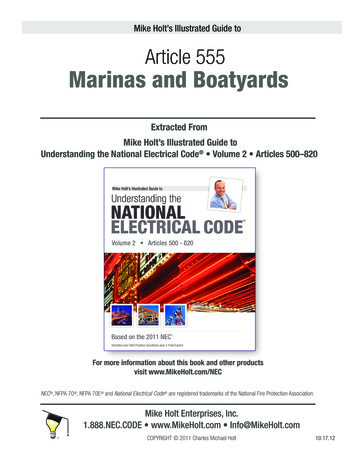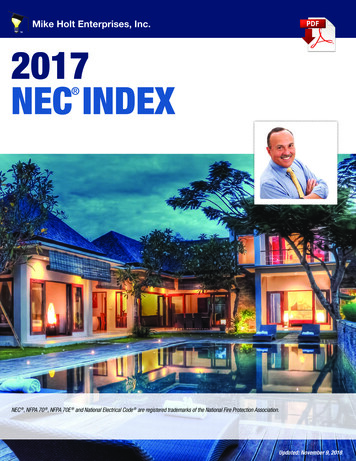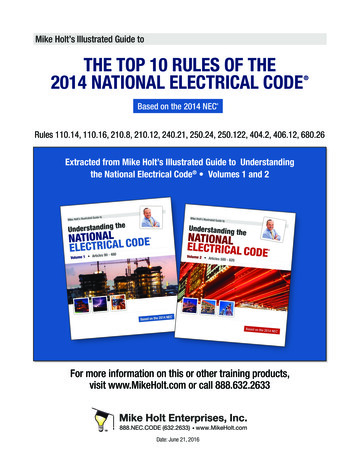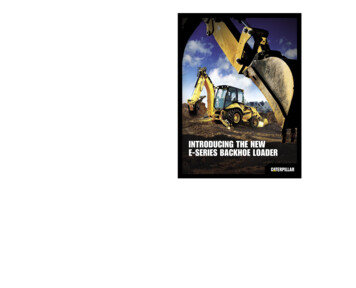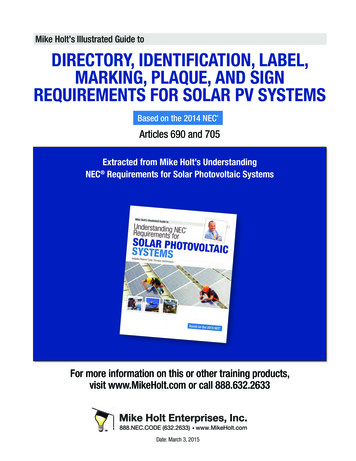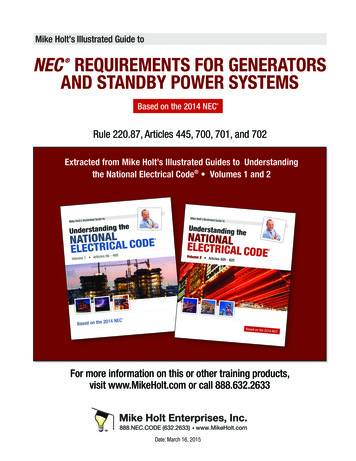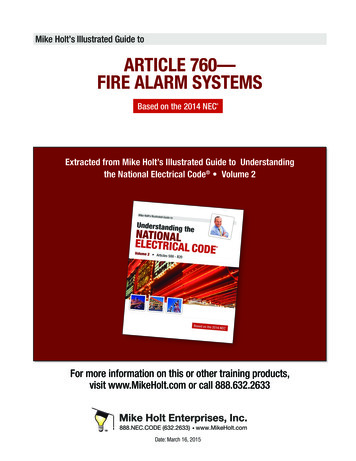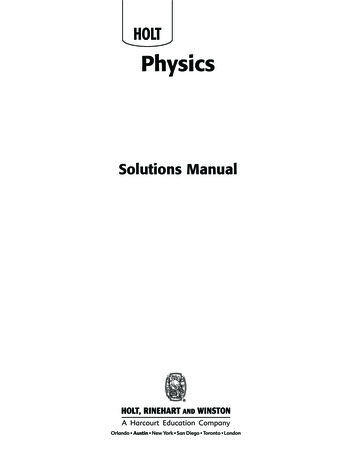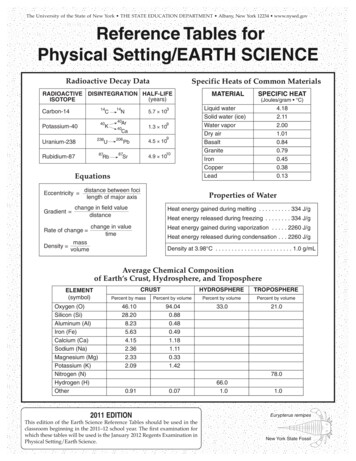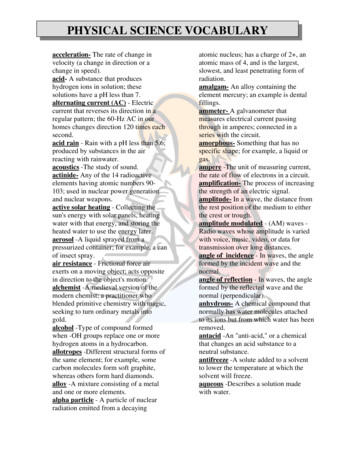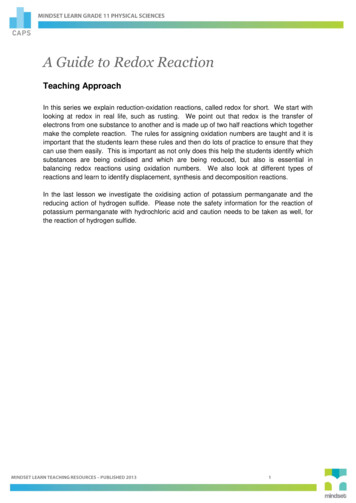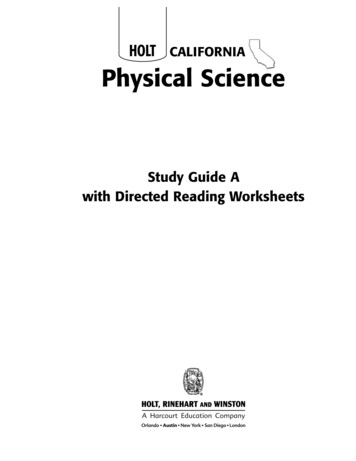
Transcription
HOLT CALIFORNIAPhysical ScienceStudy GuideGuide AAStudywith Directed Reading Worksheets
TO THE STUDENTDo you need to review the concepts in the text? If so, this booklet will help you. The StudyGuide is an important tool to help you organize what you have learned from the chapter sothat you can succeed in your studies. The booklet contains a Directed Reading worksheetand a Vocabulary and Section Summary worksheet for each section of the chapter.Use these worksheets in the following ways: as a reading guide to identify and study the main concepts of each chapter before or afteryou read the text as a place to record and review the main concepts and definitions from the text as a reference to determine which topics you have learned well and which topics you mayneed to study furtherCopyright by Holt, Rinehart and WinstonAll rights reserved. No part of this publication may be reproduced or transmitted in any form or byany means, electronic or mechanical, including photocopy, recording, or any information storage andretrieval system, without permission in writing from the publisher.Teachers using HOLT CALIFORNIA SCIENCE may photocopy complete pages in sufficient quantities forclassroom use only and not for resale.HOLT and the “Owl Design” are trademarks licensed to Holt, Rinehart and Winston, registered in theUnited States of America and/or other jurisdictions.Printed in the United States of AmericaIf you have received these materials as examination copies free of charge, Holt, Rinehart and Winston retainstitle to the materials and they may not be resold. Resale of examination copies is strictly prohibited.Possession of this publication in print format does not entitle users to convert this publication, or any portion of it,into electronic 13: 978-0-03099-395-41 2 3 4 5 6 7 054 11 10 09 08 07 06
ContentsThe Nature of Physical ScienceDirected Reading A Worksheets . . . . . . . . . . . . . . . . . . . . . . . . . . . . . . . . . 1Vocabulary and Section Summary A Worksheets . . . . . . . . . . . . . . . . . . 12Data in ScienceDirected Reading A Worksheets . . . . . . . . . . . . . . . . . . . . . . . . . . . . . . . . 15Vocabulary and Section Summary A Worksheets . . . . . . . . . . . . . . . . . . 25Properties of MatterDirected Reading A Worksheets . . . . . . . . . . . . . . . . . . . . . . . . . . . . . . . . 29Vocabulary and Section Summary A Worksheets . . . . . . . . . . . . . . . . . . 40States of MatterDirected Reading A Worksheets . . . . . . . . . . . . . . . . . . . . . . . . . . . . . . . . 43Vocabulary and Section Summary A Worksheets . . . . . . . . . . . . . . . . . . 49Elements, Compounds, and MixturesDirected Reading A Worksheets . . . . . . . . . . . . . . . . . . . . . . . . . . . . . . . . 52Vocabulary and Section Summary A Worksheets . . . . . . . . . . . . . . . . . . 62Introduction to AtomsDirected Reading A Worksheets . . . . . . . . . . . . . . . . . . . . . . . . . . . . . . . . 66Vocabulary and Section Summary A Worksheets . . . . . . . . . . . . . . . . . . 74The Periodic TableDirected Reading A Worksheets . . . . . . . . . . . . . . . . . . . . . . . . . . . . . . . . 77Vocabulary and Section Summary A Worksheets . . . . . . . . . . . . . . . . . . 86Chemical BondingDirected Reading A Worksheets . . . . . . . . . . . . . . . . . . . . . . . . . . . . . . . . 88Vocabulary and Section Summary A Worksheets . . . . . . . . . . . . . . . . . . 96Chemical ReactionsDirected Reading A Worksheets . . . . . . . . . . . . . . . . . . . . . . . . . . . . . . . . 99Vocabulary and Section Summary A Worksheets . . . . . . . . . . . . . . . . . 105Chemical CompoundsDirected Reading A Worksheets . . . . . . . . . . . . . . . . . . . . . . . . . . . . . . . 107Vocabulary and Section Summary A Worksheets . . . . . . . . . . . . . . . . . 118Copyright by Holt, Rinehart and Winston. All rights reserved.Holt California Physical ScienceiiiStudy Guide A
The Chemistry of Living ThingsDirected Reading A Worksheets . . . . . . . . . . . . . . . . . . . . . . . . . . . . . . . 121Vocabulary and Section Summary A Worksheets . . . . . . . . . . . . . . . . . 126Matter in MotionDirected Reading A Worksheets . . . . . . . . . . . . . . . . . . . . . . . . . . . . . . . 128Vocabulary and Section Summary A Worksheets . . . . . . . . . . . . . . . . . 139Forces and MotionDirected Reading A Worksheets . . . . . . . . . . . . . . . . . . . . . . . . . . . . . . . 142Vocabulary and Section Summary A Worksheets . . . . . . . . . . . . . . . . . 152Forces in FluidsDirected Reading A Worksheets . . . . . . . . . . . . . . . . . . . . . . . . . . . . . . . 155Vocabulary and Section Summary A Worksheets . . . . . . . . . . . . . . . . . 164Stars, Galaxies, and the UniverseDirected Reading A Worksheets . . . . . . . . . . . . . . . . . . . . . . . . . . . . . . . 166Vocabulary and Section Summary A Worksheets . . . . . . . . . . . . . . . . . 178Our Solar SystemDirected Reading A Worksheets . . . . . . . . . . . . . . . . . . . . . . . . . . . . . . . 182Vocabulary and Section Summary A Worksheets . . . . . . . . . . . . . . . . . 203Copyright by Holt, Rinehart and Winston. All rights reserved.Holt California Physical ScienceivStudy Guide A
NameClassDateSkills WorksheetDirected Reading ASection: Science and Scientists (pp. 8–13)STARTING WITH A QUESTIONWrite the letter of the correct answer in the space provided.1. What is knowledge obtained by investigating the natural world called?a. questionsb. sciencec. factsd. natureIn Your Own Neighborhood2. What might happen if you looked at your neighborhood in a new way?a. You might ask questions.b. You might discover a new planet.c. You might get sick.d. You might not get home.The World and Beyond3. What places do scientists ask questions about?a. only about Earthb. only about what’s around themc. only about things they seed. about any place in the universeINVESTIGATION: THE SEARCH FOR ANSWERSResearchUse the terms from the following list to complete the sentences below.experimentationresearchobservation4. Looking up information on the Internet is.5. Carefully looking and recording what you see is.6. Using different mirrors to see how your reflection changes is.Copyright by Holt, Rinehart and Winston. All rights reserved.Holt California Physical Science1The Nature of Physical Science
NameClassDateDirected Reading A continuedAPPLYING THE ANSWERSSaving Lives7. How have scientists helped protect people during automobileaccidents?a. Scientists have made cars faster.b. Scientists have made larger engines.c. Scientists have designed air bags.d. Scientists have made fuel less expensive.Saving Resources8. What has science done to help make resources last longer?a. found ways to recycle steelb. found ways to use more waterc. found ways to avoid recyclingd. found ways to fix used carsProtecting the Environment9. How do chlorofluorocarbons harm the environment?a. They keep sunlight from Earth.b. They pollute water.c. They harm the ozone layer.d. They cause storms.10. What does the ozone layer do?a. It keeps storms from harming Earth.b. It protects the planet from harmful UV light.c. It allows more sunlight to reach the planet.d. It pollutes the air.SCIENTISTS EVERYWHEREMeteorologistMatch the correct description with the correct term. Write the letter in the spaceprovided.11. a scientist who studies volcanoes12. a person who studies the atmospherea. meteorologistb. ecologistc. geochemist13. a person who draws scientific pictures14. a person who studies the make-up of rocksd. volcanologiste. science illustrator15. a person who studies living things andtheir environmentCopyright by Holt, Rinehart and Winston. All rights reserved.Holt California Physical Science2The Nature of Physical Science
NameClassDateSkills WorksheetDirected Reading ASection: Scientific Methods (pp. 14–21)WHAT ARE SCIENTIFIC METHODS?Write the letter of the correct answer in the space provided.1. What are the ways that scientists answer questions andsolve problems?a. physical scienceb. physicsc. observationsd. scientific methodsASKING A QUESTION2. In the figure showing scientific methods, which of the following isNOT a step?a. testing the hypothesisb. answering a questionc. drawing conclusionsd. making observations3. How do scientists use scientific methods?a. They always use all the steps.b. They always use the steps in the same order.c. They use the steps in different ways.d. They never do steps over again.4. What does asking questions help scientists to do?a. find answers with less investigationb. focus the purpose of an investigationc. memorize answersd. know where to find answers5. What is the word for using the senses to gather information?a. investigationb. measurementc. knowledged. observationCopyright by Holt, Rinehart and Winston. All rights reserved.Holt California Physical Science3The Nature of Physical Science
NameClassDateDirected Reading A continuedA Real-World Question6. What is the comparison of energy output with energy input?a. efficiencyb. hypothesisc. observationd. physical science7. When scientists studied boat propulsion, what did they learnabout propellers?a. They are efficient but unreliable.b. They are efficient.c. They are not very efficient.d. They are not efficient but reliable.The Importance of Boat Efficiency8. Why is it important to make boats and ships more efficient?a. to use less fuelb. to use more fuelc. to spend more moneyd. to make boats slower9. Based on their observations, what question did the MIT scientists ask?a. How can boat propulsion be made less efficient?b. How can boat propulsion be made more efficient?c. How can boat propellers be made less efficient?d. How can penguins be made more efficient?FORMING A HYPOTHESIS10. What is a possible explanation based on knowledge and observationcalled?a. a scientific lawb. physical sciencec. a theoryd. a hypothesis11. What should be true of a good hypothesis?a. It should be reusable.b. It should be testable.c. It should be a question.d. It should be untrue.Copyright by Holt, Rinehart and Winston. All rights reserved.Holt California Physical Science4The Nature of Physical Science
NameClassDateDirected Reading A continuedA Possible Answer from Nature12. What observations led Czarnowski to form his hypothesis?a. how easily penguins propel themselvesb. how easily boats propel themselvesc. how badly penguins propel themselvesd. how badly boats propel themselves13. What was Czarnowski’s hypothesis about propulsion systems?a. Propeller-driven systems are always efficient.b. Penguin-like systems are less efficient.c. Penguin-like systems are more efficient.d. Propeller-driven systems are more efficient.Making Predictions14. What do scientists do before testing a hypothesis?a. make another hypothesisb. answer all questionsc. make predictionsd. make errorsTESTING THE HYPOTHESIS15. What must you do after you form a hypothesis?a. Test the hypothesis.b. Change the hypothesis.c. Disprove a prediction.d. Answer the hypothesis.16. What should you do if you test your hypothesis and find that it is offthe mark?a. Stop working on the problem.b. Change the hypothesis.c. Don’t change the hypothesis.d. Don’t test the hypothesis again.Controlled Experiments17. What did the MIT scientists use to test their hypothesis?a. a model penguinb. a boat with a penguin-like shapec. a boat with penguin-like flippersd. a computer modelCopyright by Holt, Rinehart and Winston. All rights reserved.Holt California Physical Science5The Nature of Physical Science
NameClassDateDirected Reading A continuedUse the terms from the following list to complete the sentences below.controlled experiment experimental groupvariable parametercontrolled parameter18. A group that is the same as the control group except for one factor isa(n).19. A factor that makes the experimental group different from the controlgroup is a(n).20. An experiment that compares results from a control group and experimentalgroups is a(n).21. A factor that is kept the same between groups isa(n).Testing ProteusWrite the letter of the correct answer in the space provided.22. What are any pieces of information gathered through experimentationcalled?a. factorsb. particlesc. ideasd. dataANALYZING THE RESULTS23. What must you find out after conducting an experiment andcollecting data?a. if the answers are rightb. if the results support your hypothesisc. if the answers can be correctedd. if the results can be changed24. Why do scientists do calculations and create tables and graphs?a. to help them develop hypothesesb. to make analyzing results easierc. to impress other scientistsd. to conduct a controlled experimentCopyright by Holt, Rinehart and Winston. All rights reserved.Holt California Physical Science6The Nature of Physical Science
NameClassDateDirected Reading A continuedAnalyzing Proteus25. What were used to show the data collected in the Proteus experiment?a. books and reportsb. propellers and flippersc. line and bar graphsd. television and radioDRAWING CONCLUSIONS26. What must you do at the end of an investigation?a. Draw a conclusion.b. Draw a bar graph.c. Draw a picture.d. Make a line graph.The Proteus Conclusion27. What conclusion did the scientists come to after they analyzed resultsof the Proteus test?a. Their hypothesis was not supported.b. They needed a new investigation.c. Their hypothesis was supported.d. They had too much data.COMMUNICATING RESULTS28. Why is it important to communicate the results of scientificinvestigations?a. so other scientists can verify your resultsb. to get the creditc. because the question is answeredd. to prevent other scientists from doing their own tests29. Where did the MIT scientists publish their results about Proteus?a. nowhereb. television, radio, and the Internetc. academic papers, science magazines, and the Internetd. books, magazines, and comic booksCopyright by Holt, Rinehart and Winston. All rights reserved.Holt California Physical Science7The Nature of Physical Science
NameClassDateSkills WorksheetDirected Reading ASection: Safety in Science (pp. 22–27)KEEPING YOURSELF SAFEWrite the letter of the correct answer in the space provided.1. Which of the following is NOT a way to keep yourself safe in a lab?a. wearing proper safety equipmentb. being careful to prevent accidentsc. bumping into people in the labd. using lab materials in a safe wayAvoiding Accidents2. How can you help avoid accidents in the lab?a. Pay attention, and follow directions.b. Don’t ask questions or do experiments.c. Walk around, and talk to your friends.d. Ignore what is happening around you.Reporting Accidents3. If there is an accident, what should you do?a. Run out of the classroom.b. Let your teacher know right away.c. Don’t tell anyone.d. Scream and jump up and down.ELEMENTS OF SAFETYUnderstanding Safety Symbols4. What do safety symbols tell you?a. how to bake cookiesb. what precautions to takec. how to do experimentsd. when to leave the classroomMatch each safety symbol with the correct meaning. Write the letter in the spaceprovided.5.a. sharp objectb. heating safety6.c. clothing protection7.Copyright by Holt, Rinehart and Winston. All rights reserved.Holt California Physical Science8The Nature of Physical Science
NameClassDateDirected Reading A continuedFollowing Safety Symbols8. What will your teacher explain to you about each safety symbol?a. what precautions it requiresb. how to draw itc. where to find itd. when to follow it9. What should you do if you see the symbol for heating safety?a. Wash your hands.b. Stop working on the activity.c. Clear flammable things off your work area.d. Take off your safety equipment.Following Directions10. What should you always do before a science activity?a. Take off your safety equipment.b. Talk to your best friend about it.c. Read all instructions very carefully.d. Leave the room.11. If you don’t understand directions, who should you ask toexplain them?a. the school principalb. your parentsc. your best friendd. your science teacherNeatness12. Why should you be neat when you work in a science lab?a. to make your work area look niceb. to please your teacherc. so you will be saferd. so you can go home earlyUsing Proper Safety Equipment13. What should you always wear when you enter the lab area?a. heat-resistant glovesb. safety gogglesc. rubber bootsd. ear phonesCopyright by Holt, Rinehart and Winston. All rights reserved.Holt California Physical Science9The Nature of Physical Science
NameClassDateDirected Reading A continued14. What should you do if you need to handle hot objects?a. Use your apron.b. Ask your friend to handle them.c. Call the teacher.d. Wear heat-resistant gloves.Cleaning Up15. What should you do with a cracked glass bowl after an activity?a. Give it to your teacher.b. Ask your friend what to do with it.c. Take it home.d. Try to repair it.Match each description with the correct safety element. Write the letter in thespace provided.a. recognizing safety symbols16. clearing books off yourwork areab. following directionsc. practicing neatness17. wiping your work area withdamp paper towelsd. using the right safety equipment18. wearing goggles and an aprone. cleaning up properly19. knowing what the symbol of asmall animal means20. doing what the instructionsand your teacher sayRESPONDING TO ACCIDENTSWrite the letter of the correct answer in the space provided.21. Why should you know where emergency equipment is located inyour lab?a. so you can do experimentsb. so you can get it after an accidentc. so you can prevent accidentsd. so you can go home earlyCopyright by Holt, Rinehart and Winston. All rights reserved.Holt California Physical Science10The Nature of Physical Science
NameClassDateDirected Reading A continuedProper Accident Procedures22. What should you do first after an accident?a. Tell the principal.b. Leave the area with your friends.c. Scream for help.d. Make sure you are safe.Use the terms from the following list to complete the sentences below.first aidaccident23. Always report a(n)to your teacher even if you areafraid you will get in trouble.24. Emergency medical care for someone who has been hurt or who is sick iscalled.Procedures for Accidental InjuriesWrite the letter of the correct answer in the space provided.25. What can you do if someone gets a heat burn?a. Apply pressure with a paper towel.b. Hold the burn under cold water.c. Bring food to the injured person.d. Wash out the eyes in an eye bath.26. How should you treat a cut?a. Wash the cut in an eye bath.b. Rinse the cut and hold it under cold water.c. Rinse the cut and apply pressure.d. Bring food to the injured person.Copyright by Holt, Rinehart and Winston. All rights reserved.Holt California Physical Science11The Nature of Physical Science
NameClassDateSkills WorksheetVocabulary and Section Summary AScience and ScientistsVOCABULARYIn your own words, write a definition of the following term in the space provided.1. scienceSECTION SUMMARYRead the following section summary. Scientific progress is made by asking meaningful questions and conductingcareful investigations. Three methods of investigation are research, observation, and experimentation. Science affects people’s daily lives. Science can help save lives and resourcesand can help improve the environment. There are several types of scientists and many jobs that use science.Copyright by Holt, Rinehart and Winston. All rights reserved.Holt California Physical Science12The Nature of Physical Science
NameClassDateSkills WorksheetVocabulary and Section Summary AScientific MethodsVOCABULARYIn your own words, write a definition of the following term in the space provided.1. scientific methods2. observation3. hypothesis4. dataSECTION SUMMARYRead the following section summary. Scientific methods are the ways in which scientists answer questions and solveproblems. Asking a question usually results from making an observation. Questioning isoften the first step in using scientific methods. A hypothesis is a possible explanation or answer to a question. A good hypothesis is testable by an experiment. After performing an experiment, you should analyze your results. Analyzing isusually done by using calculations, tables, and graphs. After analyzing your results, you should draw conclusions about whether yourhypothesis is supported. Communicating your results allows others to check or continue your work. Youcan communicate through reports, posters, and the Internet.Copyright by Holt, Rinehart and Winston. All rights reserved.Holt California Physical Science13The Nature of Physical Science
NameClassDateSkills WorksheetVocabulary and Section Summary ASafety in ScienceVOCABULARYIn your own words, write a definition of the following term in the space provided.1. first aidSECTION SUMMARYRead the following section summary. Appropriate safety precautions must always be taken when conducting scientific investigations. Scientists use symbols to alert them to particular dangers that they face whenperforming experiments in science. Goggles, gloves, and aprons are proper safety equipment that should be used ina science laboratory. If you suffer any injury during an experiment, inform your teacher immediately. Proper first-aid procedures must be followed when an accident occurs inthe lab.Copyright by Holt, Rinehart and Winston. All rights reserved.Holt California Physical Science14The Nature of Physical Science
NameClassDateSkills WorksheetDirected Reading ASection: Tools and Models in Science (pp. 42–49)Write the letter of the correct answer in the space below.1. How can a tool best be described?a. anything that helps you do a taskb. anything that gives you energyc. anything that uses electricityd. anything that has a handleTOOLS IN SCIENCE2. Which of the following should you do when you collect data?a. Use faulty measurement tools.b. Clean your tools.c. Use the proper measurement tools.d. Use inaccurate measurements.3. Which of the following tools is NOT used to evaluate and analyze data?a. calculatorb. meterstickc. graphd. computerMAKING MEASUREMENTS4. How was an inch measured in England many years ago?a. by using grains of barleyb. by using calculatorsc. by using flower petalsd. by using corn stalksThe International System of Units5. What is the system of measurement used by most scientists called?a. the International System of Measuresb. the French System of Unitsc. the Universal Unit Systemd. the International System of UnitsCopyright by Holt, Rinehart and Winston. All rights reserved.Holt California Physical Science15Data in Science
NameClassDateDirected Reading A continued6. Which of the following is another name for the SI system ofmeasurement?a. the French academy systemb. the metric systemc. the International Unit Systemd. the National System of Measurement7. What are all units of the SI system of measurement based on?a. the number 5b. the number 10c. the number 1,000d. the number 158. In measuring, what does kilo- mean?a. 10 timesb. 100 timesc. 1,000 timesd. 10,000 times9. In measuring, what does milli- mean?a. 1/100 timesb. 5/100 timesc. 1/2,000 timesd. 1/1,000 timesLength10. What is the basic SI unit of length?a. a meterc. a kelvinb. a kilogramd. a milliMassUse the terms from the following list to complete the sentences below.massvolumeliterdensitykilogram11. The amount of matter in an object is its12. The basic SI unit for mass is the.13. A measure of the size of an object is its.14. A unit of measure used to express liquid volume isthe15. The ratio of the mass of a substance to the volume of the substanceis its.Copyright by Holt, Rinehart and Winston. All rights reserved.Holt California Physical Science16Data in Science
NameClassDateDirected Reading A continuedTemperatureWrite the letter of the correct answer in the space below.16. Which of the following is a measure of how hot or how cold something is?a. temperatureb. massc. lengthd. volume17. Which of the following are NOT units used to measure temperature?a. gramsb. degrees Fahrenheitc. kelvinsd. degrees CelsiusMODELS IN SCIENCE18. What is a representation of an object or process called?a. an estimateb. a samplec. a modeld. data19. Which of the following uses something familiar to explain somethingunfamiliar?a. a thermometerb. a toolc. a calculatord. a modelPhysical ModelsUse the terms from the following list to complete the sentences below.conceptual modelmathematical modelphysical modelvariable20. A doll is an example of a(n).21. A model can make an inaccurate prediction if a wrongis used.22. A model that puts many ideas together to explain or summarize something iscalled a(n).23. A model that is used to predict the weather is an example of a(n).Copyright by Holt, Rinehart and Winston. All rights reserved.Holt California Physical Science17Data in Science
NameClassDateDirected Reading A continuedModels: The Right SizeWrite the letter of the correct answer in the space below.24. Which of the following is used to represent things that are very smallor very large?a. a modelb. a cylinderc. a toold. dataThe Limits of Models25. Why are models limited in their usefulness?a. Models are too difficult to make.b. Models are never used in science.c. Models are not exactly like the real object.d. Models are never accurate.USING MODELS FOR SCIENTIFIC PROGRESS26. Which of the following statements about models is NOT true?a. Scientists use models to communicate information.b. Models cannot help explain difficult information.c. Models can represent scientific ideas and objects.d. Models help explain difficult information.SCIENTIFIC THEORIESMatch the correct definition with the correct term. Write the letter in the spaceprovided.27. a system of ideas that explains observationsand is supported by scientific evidence28. a statement or equation that reliablypredicts events under certain conditionsa. lawb. theoryc. model29. a representation used by scientists toexplain theories and construct lawsCopyright by Holt, Rinehart and Winston. All rights reserved.Holt California Physical Science18Data in Science
NameClassDateSkills WorksheetDirected Reading ASection: Organizing Your Data (pp. 50–55)CREATING A DATA TABLEWrite the letter of the correct answer in the space below.1. Which of the following can be the first step in organizing data?a. Choose a topic.b. Gather information.c. Create a data table.d. Analyze the data.Organizing: The First Step2. Which of the following must you determine before starting anexperiment?a. what information you will gatherb. what conclusions you will drawc. how you will interpret the datad. whether your hypothesis is correctIndependent and Dependent Variables3. The factor in an experiment that the investigator can change iscalled what?a. the dependent variableb. an observationc. the independent variabled. an estimate4. Where is the independent variable found in a data table?a. in the first columnb. in the estimate columnc. in the second columnd. in the experiment column5. The factor that the scientist measures in an experiment is called what?a. the independent variableb. the densityc. an estimated. the dependent variable6. Where is the dependent variable found in a data table?a. in the first columnb. in the estimate columnc. in the second columnd. in the experiment columnCopyright by Holt, Rinehart and Winston. All rights reserved.Holt California Physical Science19Data in Science
NameClassDateDirected Reading A continuedVariable and Controlled Parameters7. How do controlled parameters and variable parameters differ?a. Controlled parameters can be measured, and variable parameters cannot.b. Controlled parameters stay constant, and variable parameters change.c. Controlled parameters change, and variable parameters do not.d. Controlled parameters and variable parameters do not differ.CREATING A GRAPH8. What do graphs help you do?a. represent an object or systemb. explain hypotheses and observationsc. measure the size of an objectd. identify trends and make predictionsAxesUse the terms from the following list to complete the sentences below.rangedependent variableaxisindependent variable9. One of two or more reference lines that mark the borders of a graph is calleda(n).10. The x-axis on a graph usually represents thein adata table.11. The y-axis on a graph usually represents thein adata table.12. To find theof an axis, subtract the smallest valueof a variable from the largest value of the same variable.ScaleUse the terms from the following list to complete the sentences below.scaleline of best fittitle13. The size that is used for each box on the graph is called the.14. A smooth line that includes some but not all data points is called the.15. The independent and dependent variables are often included in a graph’s.Copyright by Holt, Rinehart and Winston. All rights reserved.Holt California Physical Science20Data in Science
NameClassDateDirected Reading A continuedPATTERNS SHOWN BY GRAPHSMatch the correct definition with the correct term. Write the letter in the spaceprovided.16. a graph that shows the relationship betweenvariables with a straight line17. a graph that cannot show the relationshipbetween variables as a straight linea. nonlinear graphb. linear graphc. directd. inverse18. a relationship in which the dependentvariable and the independent variable bothincrease19. a relationship in which one variableincreases while the other variable decreasesUsing Computers to Create GraphsWrite the letter of the correct answer in the space below.20. Which of the following can help scientists organize data?a. a theoryb. a meterstickc. a computerd. a lawCopyright by Holt, Rinehart and Winston. All rights reserved.Holt California Physical Science21Data in Science
NameClassDateSkills WorksheetDirected Reading ASection: Analyzing Your Data (pp. 56–61)WHY MATHEMATICS?W
Holt California Physical Science 4 The Nature of Physical Science Name Class Date Directed Reading A continued A Real-World Question _ 6. What is the comparison of energy output with energy input? a. efficiency b. hypothesis c. observation d. physical science _ 7. When scientis
